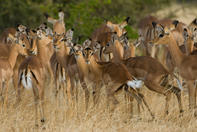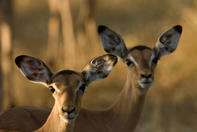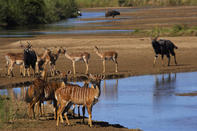Browser and Graser
Impala are very common antelope in the Lowveld but they are also one of the most superbly adapted species in this area. Impala maximize on whatever food is available.

Where most antelope are either browsers or grazers predominantly, impala are mixed feeders and will browse leaves and graze grass. They tend to browse more in winter when food is scarce and graze in summer as grass has higher protein and less secondary compounds to digest when it is freshly grown. Impala are water dependent and will always be within a 5 km radius of water where they will drink daily.
Common But Well Adapted

Pilo-erection is a technique used by mammals for different reasons. It refers to the ability of most mammals to raise the hair on their bodies, just like goose-bumps in humans. Impala employ pilo-erection on cooler mornings and at this time their usually shiny coats take on a duller, darker appearance.
By raising the hair on their bodies they trap a layer of air close to the skin, which warms up from the impala’s body heat and in turn keeps the animal a little more insulated against the cold.
Large Ears and Eyes

Impala have excellent senses. Their large ears detect sounds easily and their huge eyes provide them with excellent vision. Because an impala’s most imminent survival threat comes in the form of predators, they, like most antelope, have side-positioned eyes which afford them excellent peripheral vision.
Once danger of whatever form is detected, impala employ a loud alarm snort to alert the other members of the group. Although this seems very neighbourly, impala do this to spur the rest of the herd into flight and as they scatter explosively in all directions, the ensuing chaos works as a shield to the individual.
To further succeed as herd individuals, impala have three black lines on their rumps, which are ‘follow me’ signs. It stands to benefit one impala to have another individual running behind it should there be a predator in pursuit, and to have another in front of it should there be a potential ambush ahead. The effect of inducing others to follow automatically creates this ‘middle man’ safety effect.
Mix with Others

Impala are often found associating with other species while they feed. Often in the case of other herbivores like warthogs, this is simply due to a mutually desired food source but animals in mixed feeding parties also benefit from shared vigilance and warning systems.
Baboons and impala associate often. Impala pick up scraps of fruit or flowers dropped by baboons feeding in fruiting trees and while they feast, impala provide vigilance.
There is seldom an impala in a feeding group that hasn’t got its head up and watching for danger. As one head goes down to feed again, another pops up to watch while chewing a mouthful. Baboons also offer an early warning to the impala for predators as they have better vantage from high up in the trees.
By Megan Emmett